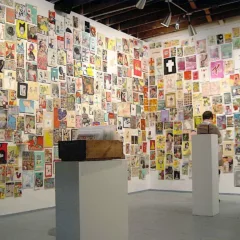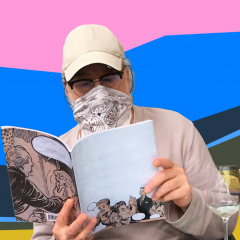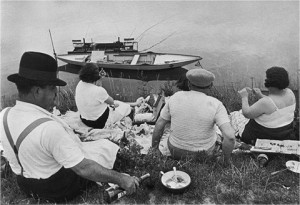
After the crowds at the FIAC in Paris subside, the gathering at Paris Photo, held in the Carrousel du Louvre, creates a different kind of picture show. Intimate and targeted to serious collectors of photography, only 89 galleries, and 13 publishers including book dealers and other image merchants appear fresh and pressed in the well-appointed marble basement of the world’s largest museum.
Paris is a good place for this kind of art schmooze because it was Frenchman Louis Daguerre (1787 – 1851), who helped develop and launch the photo business in the City of Light in 1839. It was called then, “a gift to the free world,” and that gift keeps on giving. More than 40,000 collectors and observers came (November 19-22) and took pictures of pictures, and spent a pile of euros for iconic, historic and contemporary photography works.
Indeed, there were plenty of early samples of the first kind of photographic images using all kinds of pin-hole gadgets, capturing and exporting to culture the essence of nature. There were ample supplies of 20th century masters as well : Brassaï, Cartier-Bresson, Stieglitz and others who changed the way we perceive our reality.
I had a fascinating conversation with Howard Greenberg, the New York dealer and his staff about the plethora of fake and unauthorized prints, particularly the case of the William Robertson’s sale of Lewis Hine’s prints (the monies were returned to buyers when Robertson settled privately). After the 1950s, technology turned in paper manufacturing, and a bleaching agent was added to the process, so that not only were supports brighter, but supposedly older prints could be quickly authenticated: A black light would show “florescence.” Many of the older works of Cartier-Bresson on view on his stand, such as “On the banks of the Marne,” (1938), remain astonishing and are a joy to see. And they are original prints, each with their defects, particularities, and vintage paper. Greenberg said that at the time Cartier-Bresson printed these, few were ever editioned. “Numbering prints is a contemporary invention,” he said. “Often they weren’t even signed.”
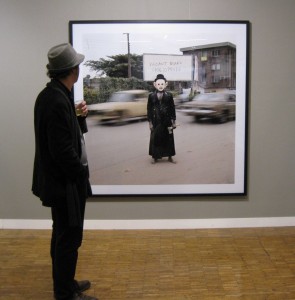
Some years ago, I noted how photoshopped images were turning photographs into painting. Loretta Lux’s slight distortions of children’s heads and bodies and the creation of a surreal environmental space, was a revelation and her work achieved high acclaim and high prices. Photographs are getting larger and larger thanks to massive format inkjet printers and high-resolution images. So I’m was not surprised to see Pieter Hugo’s midget sugar cane worker, life-sized, staring back menacingly, machete in hand, at would-be buyers or flâneurs like myself. The Capetown, South African dealer Michael Stevenson exhibited several of these large-scale works by Hugo, including the haunting – Escort Kama, (2008) – a ghost like image standing as if it was his telephone number in the billboard behind him in a busy street in Nigeria. It’s very hard to tell what’s real and what’s not, anymore though. But such is the nature of Voodoo. Anything can be photo-shopped in, just ask Gilbert & George, who told me they own the UK’s most advanced image manipulation equipment.
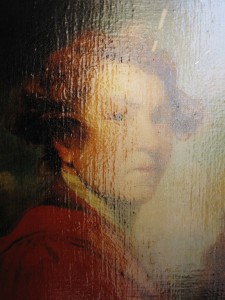
I enjoyed the tides bringing in the new and washing out the old, but everything is still here in the wash. For water works, however, Sugimoto’s ocean view (also at Michael Stevenson) is quite exquisite and as the French say, juste. The Japanese star is a poet when capturing nothingness on film. It’s always about something. In fact, it’s nearly impossible to photograph nothing. Yet it seems many artists are re-working conceptual gimmicks. Here one of my photo works made at the show after Jorma Puranen, the Finnish photographer (Galerie Anhava). His efforts at re-scaling and re-picturing Old Masters are plainly titled “Shadows, reflections and all that sort of thing…” followed by a number and the date. His C-prints are vastly more expensive, but you can have mine free simply by dragging it off the page and turning it into your screen saver or desktop background. Or printing it: Click here for the high res file. Go ahead. No © here.
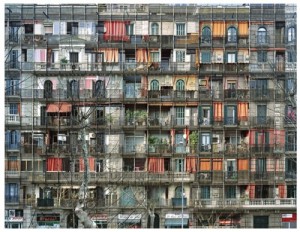
Architectural portraits are still the rage and Frenchman, Stéphane Couturier at Galerie Polaris, continues his exploration of apartment block portraiture. Barcelona, #1 (2008) is one of the latest examples of his work. The buildings, with all their funky details – laundry hanging from the balconies, scaffolding, lights on, lights off, rusted and decaying façades detail the lived-in cities in which we live. We’ve all seen these images before – every time we visit an aunt and look out the windows to see how the neighbors are getting along, or stare out a hotel window in some overwhelming city. There is pleasure in the large-scale cropping of the grid of modernity, even if it signifies wide-scale madness.
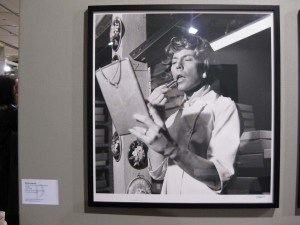
On this subject – madness – there was a striking installation of works by Frenchman Michel Journiac. His 24 hours in the live of an ordinary woman from 1974 – 1994 record the artist’s life as a cross-dresser, years before this performance art in photography was institutionalized by artists like Cindy Sherman. There is something touching and painful and funny and revealing about this out-front and sassy self-examination of the artist. Dorian Gray with a Rolleiflex. You can see more of these works at the gallery’s web site: Patricia Dorfman (Paris), currently running a show about the artist’s work.
Finally, the fair was dedicated to works from Arab countries and Van Leo’s Sherihan actrice égyptienne, Le Caire, Egypte, from 1976, (Collection Fondation Arabe pour l’Image) provided this year’s poster girl. It’s one of those beautiful, iconic images that is both strange and familiar, which is sometimes the point of photography.
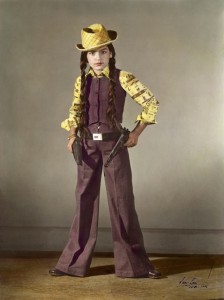
Note: Flavorwire put up a neat little slide show of some of the works on view : Take a look: Slide show Paris Photo.
Matthew Rose is an artist and writer based in Paris. His most recent project is A Book About Death, which opens a new chapter in São Paulo, Brazil at MUBE, in February 2010.


